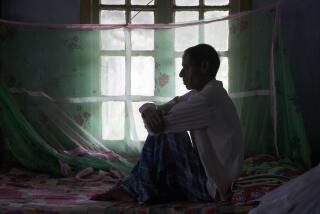Gay Sex Called Key to Rise in Syphilis
- Share via
Men engaged in risky homosexual activity are fueling a sharp increase in the incidence of syphilis and a smaller but worrisome rise in gonorrhea resistant to common antibiotics, federal researchers said Tuesday.
The increases are seen at a time when sexually transmitted disease rates among historically important risk groups, especially women and minorities, have been declining, according to a new report from the Centers for Disease Control and Prevention.
The diseases “are a significant and ongoing threat to millions of Americans,” said Dr. Ronald O. Valdiserri, acting director of CDC’s National Center for HIV, STD and TB Prevention. They cost the healthcare system $13 billion per year, he said.
Health authorities made major inroads into slowing syphilis transmission during the 1990s, bringing the annual number of new cases during 2000 to the lowest level since recordkeeping began in 1941.
Between 2000 and 2004, however, the rate rose by 29% to a total of 7,980 cases, with most of the increase occurring among men.
Men engaging in homosexual activities accounted for 64% of syphilis infections in 2004, compared with about 5% in 1999, said Dr. John M. Douglas Jr., director of the CDC’s division of sexually transmitted disease prevention.
Although the number of cases is small, experts say the data are worrisome because increases in sexually transmitted diseases are thought to be precursors of increases in the transmission of the AIDS virus, which is much more difficult to combat.
“We have very good and sound information showing increases in high-risk behaviors among men having sex with men since 1999,” fueling the increase in syphilis, Valdiserri said.
Risky behavior has increased because of growing crystal methamphetamine use, he said -- first on the West Coast and now on the East.
“That’s exacerbating the transmission of syphilis,” he said.
As in previous years, San Francisco had the highest incidence of syphilis, with a rate of 45.9 cases per 100,000 people. Atlanta was second with 34.6 cases, and Baltimore third with 33.2. Los Angeles ranked 24th, with five cases per 100,000.
Gonorrhea rates, in contrast, have fallen to 113.5 cases per 100,000 people in 2004 -- about 330,000 cases -- the lowest rate since 1941. Nonetheless, surveillance by the CDC in selected cities has shown that resistance to fluoroquinolone antibiotics -- the common first-line treatment for gonorrhea -- increased from 4.1% in 2003 to 6.8% in 2004.
Also, the rate of antibiotic resistance among men engaging in homosexual activity was 23.8% -- eight times the rate in heterosexuals.
Last year, the CDC recommended that fluoroquinolones no longer be used to treat the disease in men having sex with men because of the rise in resistance. They also are not recommended for use in California and Hawaii, where resistance has been widespread for years.
The reported incidence of a third sexually transmitted disease, chlamydia, also rose 5.9% last year to 319.6 cases per 100,000 people -- a total of 929,462 cases.
But Valdiserri and Douglas attributed much of that growth to new and more aggressive screening programs rather than to increased transmission.
Nonetheless, the report says that the majority of cases are still not detected or reported to the agency because of the absence of symptoms, and that the actual number of infections is as high as 2.8 million cases per year.
“Healthcare providers urgently need to step up screening for chlamydia, particularly among young, sexually active women, who are at greatest risk of infertility if the disease is not diagnosed and treated,” Douglas said.
The two other most common sexually transmitted diseases in the United States, herpes and human papilloma virus, are not reported to federal authorities, although reliable estimates of their prevalence are available from other sources.
Taking those diseases into account, Valdiserri said, the total number of sexually transmitted diseases in the United States each year is about 19 million, almost half of them among people ages 15 to 24.






